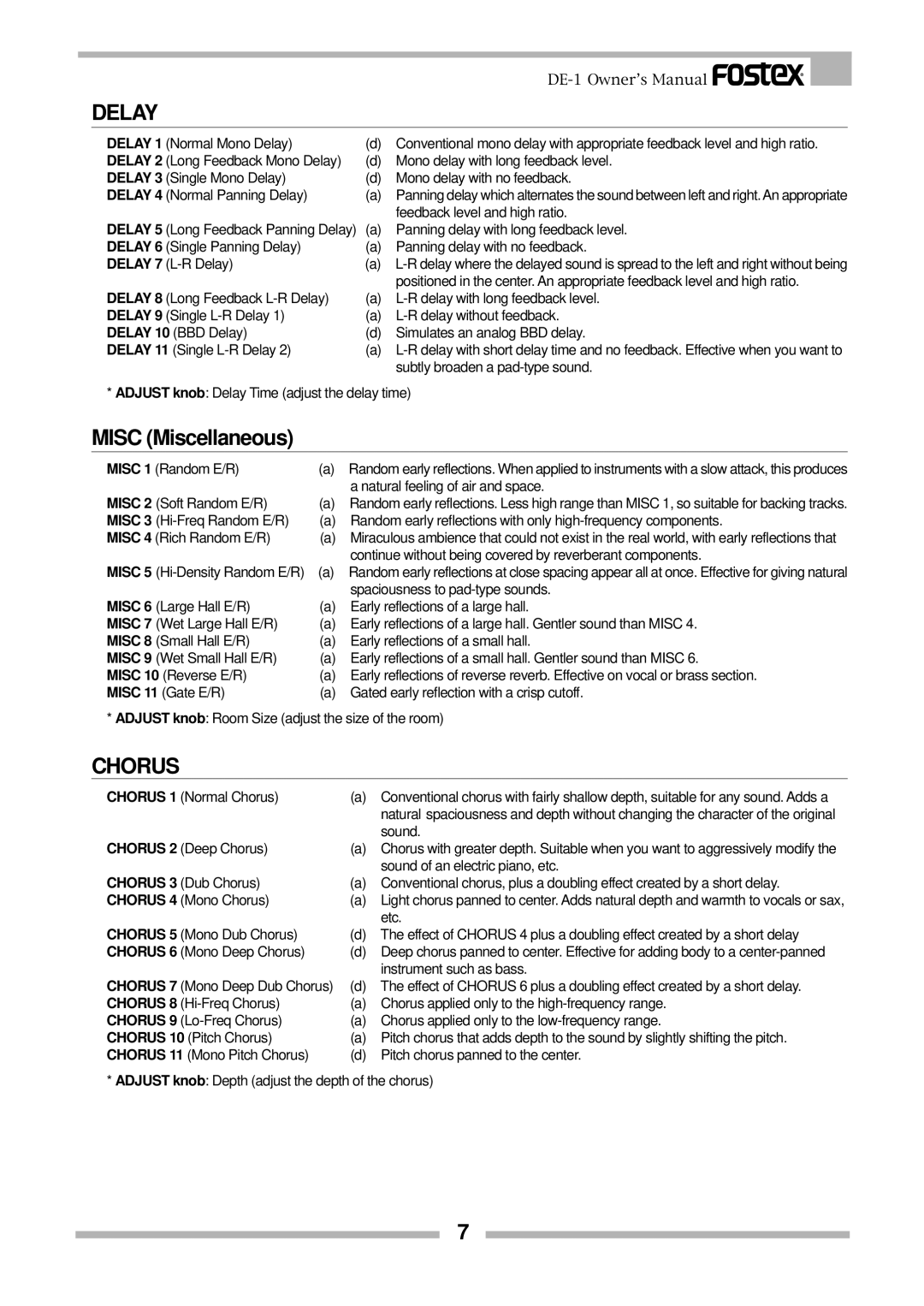
| DELAY |
|
| |
|
|
|
| |
| DELAY 1 (Normal Mono Delay) | (d) Conventional mono delay with appropriate feedback level and high ratio. | ||
| DELAY 2 (Long Feedback Mono Delay) | (d) Mono delay with long feedback level. | ||
| DELAY 3 (Single Mono Delay) | (d) Mono delay with no feedback. | ||
| DELAY 4 (Normal Panning Delay) | (a) Panning delay which alternates the sound between left and right. An appropriate | ||
|
| feedback level and high ratio. | ||
| DELAY 5 (Long Feedback Panning Delay) | (a) Panning delay with long feedback level. | ||
| DELAY 6 (Single Panning Delay) | (a) Panning delay with no feedback. | ||
| DELAY 7 | (a) | ||
|
| positioned in the center. An appropriate feedback level and high ratio. | ||
| DELAY 8 (Long Feedback | (a) | ||
| DELAY 9 (Single | (a) | ||
| DELAY 10 (BBD Delay) | (d) Simulates an analog BBD delay. | ||
| DELAY 11 (Single | (a) | ||
|
| subtly broaden a | ||
* ADJUST knob: Delay Time (adjust the delay time)
MISC (Miscellaneous)
MISC 1 (Random E/R) | (a) Random early reflections. When applied to instruments with a slow attack, this produces | |
|
| a natural feeling of air and space. |
MISC 2 (Soft Random E/R) | (a) Random early reflections. Less high range than MISC 1, so suitable for backing tracks. | |
MISC 3 | (a) Random early reflections with only | |
MISC 4 (Rich Random E/R) | (a) Miraculous ambience that could not exist in the real world, with early reflections that | |
|
| continue without being covered by reverberant components. |
MISC 5 | (a) Random early reflections at close spacing appear all at once. Effective for giving natural | |
|
| spaciousness to |
MISC 6 | (Large Hall E/R) | (a) Early reflections of a large hall. |
MISC 7 | (Wet Large Hall E/R) | (a) Early reflections of a large hall. Gentler sound than MISC 4. |
MISC 8 | (Small Hall E/R) | (a) Early reflections of a small hall. |
MISC 9 | (Wet Small Hall E/R) | (a) Early reflections of a small hall. Gentler sound than MISC 6. |
MISC 10 (Reverse E/R) | (a) Early reflections of reverse reverb. Effective on vocal or brass section. | |
MISC 11 (Gate E/R) | (a) Gated early reflection with a crisp cutoff. | |
* ADJUST knob: Room Size (adjust the size of the room)
CHORUS
CHORUS 1 (Normal Chorus) | (a) Conventional chorus with fairly shallow depth, suitable for any sound. Adds a | |
|
| natural spaciousness and depth without changing the character of the original |
|
| sound. |
CHORUS 2 (Deep Chorus) | (a) Chorus with greater depth. Suitable when you want to aggressively modify the | |
|
| sound of an electric piano, etc. |
CHORUS 3 (Dub Chorus) | (a) Conventional chorus, plus a doubling effect created by a short delay. | |
CHORUS 4 (Mono Chorus) | (a) Light chorus panned to center. Adds natural depth and warmth to vocals or sax, | |
|
| etc. |
CHORUS 5 (Mono Dub Chorus) | (d) The effect of CHORUS 4 plus a doubling effect created by a short delay | |
CHORUS 6 | (Mono Deep Chorus) | (d) Deep chorus panned to center. Effective for adding body to a |
|
| instrument such as bass. |
CHORUS 7 | (Mono Deep Dub Chorus) | (d) The effect of CHORUS 6 plus a doubling effect created by a short delay. |
CHORUS 8 | (a) Chorus applied only to the | |
CHORUS 9 | (a) Chorus applied only to the | |
CHORUS 10 (Pitch Chorus) | (a) Pitch chorus that adds depth to the sound by slightly shifting the pitch. | |
CHORUS 11 (Mono Pitch Chorus) | (d) Pitch chorus panned to the center. | |
* ADJUST knob: Depth (adjust the depth of the chorus)
7
